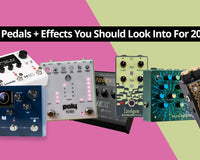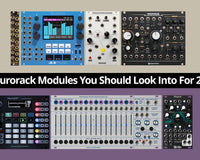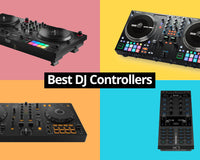Distortion is the most elemental of all audio effects. It plugs into the desire to make music that is raw, energetic, and just plain loud. Distortion seems like the simplest thing on earth – patch an instrument into any fuzz box available and glory at the way it pushes the signal to breaking point, resulting in a glorious howl of fearsome noise and transcendent overtones.
It’s not that simple, though. Listen to those overtones for a while and you will realize that distortion is – by its very nature – a richly textured sound with a great deal of nuance. Furthermore, there are many types to choose from: analogue, digital, fuzz, overdrive, bitcrush, waveshape… Plug your instrument into a different box and you may get totally different results.
Choosing the right distortion pedal or module for you will depend on the results you are looking for. A garage rock guitarist seeking warm fuzz with great sustain needs a completely different product from an industrial techno producer working on crunchy, glitched-out beats and over-modulated basslines.
In this article, we help you find the best distortion effect for you. We look at guitar pedals, desktop boxes, and Eurorack modules – and investigate different kinds of distortion for different use cases. First though, let’s look at what distortion is and how it came to be, so we can understand which kind of distortion is right for which kind of musician.
A short history of horrible noise
 Distortion is one of the first effects that guitarists sought out. There are oft-repeated stories of players like Sterling Morrison of the Velvet Underground and Link Wray slashing their speaker cones to get a distorted tone – and you may have heard the one about Keith Richards of The Rolling Stones using distortion to compensate for the band’s lack of a brass section.
Distortion is one of the first effects that guitarists sought out. There are oft-repeated stories of players like Sterling Morrison of the Velvet Underground and Link Wray slashing their speaker cones to get a distorted tone – and you may have heard the one about Keith Richards of The Rolling Stones using distortion to compensate for the band’s lack of a brass section.
It’s hard to imagine rock – or just about any other form of music – without distortion. For some musicians, it has become the be all and end all. Kevin Shields of My Bloody Valentine has claimed that his massive pedal rig is mostly different types of distortion. Meanwhile, noise artist Merzbow has released well over 100 albums that consist of pure distortion and little else.
Okay, but what is distortion? Technically, distortion is any unwanted change to a sound wave or other signal. In music, distortion is often desirable – to create a “heavier” sound, to help an instrument cut through a crowded mix, or for a myriad of other reasons. Consequently, there are plenty of distortion effects on the market, especially when it comes to guitar pedals.
This is an area where the difference between analogue and digital technology is highly significant. Turn a signal up way too loud in analogue equipment and you will likely get a warm, musical overdrive effect. Do the same thing with digital equipment and you will often get harsh “clipping” noise that seems unrelated to the original sound.
Nevertheless, there is plenty to be said for digital distortion. A lot of software and digital hardware now includes “soft-clipping” algorithms that create a more overdrive-like result. Also, by simply reducing the quality of a digital audio signal, you can introduce all sorts of interesting noise and overtones, resulting in what is often called a bitcrusher or decimator.
Broadly speaking, both overdrives and bit crushers are types of distortion. However, in the strictest sense, a distortion pedal is one that directly alters or shapes the incoming soundwave to emphasize certain harmonic overtones. When these overtones are pushed way to the front, creating a warm and saturated tone, the result is often referred to as fuzz.
Many distortion pedals and modules use some combination of overdrive, wave shaping, and fuzz. There are also plenty of products at the more adventurous end of the market that include digital clipping and bit reduction – with some even adding modulation options to create a more varied and dynamic tone. In the final analysis, it’s all distortion.
The specific type of distortion effect you seek out will depend on what type of music you are making, what instruments and other gear you are using, and – of course – your budget. Below, we look at the best distortion pedals and modules for a range of different scenarios, to help you find the one that is right for you.
Classic distortion and overdrive pedals for rockers
 For straightforward guitar effects, Boss is always a reliable name and a sensible first place to look. Boss DS-1X is a great basic distortion pedal and the Boss OS-2 is a versatile combined distortion-and-overdrive with a handy colour control that allows you to create the perfect balance between its two core two effects.
For straightforward guitar effects, Boss is always a reliable name and a sensible first place to look. Boss DS-1X is a great basic distortion pedal and the Boss OS-2 is a versatile combined distortion-and-overdrive with a handy colour control that allows you to create the perfect balance between its two core two effects.
For a straightforward, affordable, and great-sounding distortion pedal though, it is hard to beat the MXR M75 Super Badass. This may be a simple stomp box, but it is anything but modest – especially with a name like that! The M75 does indeed have a truly badass tone, which you can sculpt to your own requirements using its three-band graphic equalizer.
If you are looking for something a bit more special, with even wider tone-sculpting options, the Strymon Sunset and Death by Audio Interstellar Overdriver Deluxe are both next-level overdrive pedals. It’s hard to pick a favourite but, given that each of these is on the higher end of the price scale, you may have to choose one or the other.
If you need a more modestly priced overdrive option, the Electro-Harmonix OD Glove sounds fantastic in a range of scenarios. On a personal note, I have had surprisingly good luck using this to add crunchy distortion to sampled drums – it brings out all sorts of previously hidden textures for a richer overall sound and more rhythmic nuance.
Metal mania for advanced headbangers
For serious crunch, you cannot do better than Boss MT-2W. This is a deluxe, all-analogue version of the classic Boss MT-2 Metal Zone pedal, which is itself revered by generations of long-haired riff makers. While it is aimed mainly at metal-heads, the MT-2W is a phenomenal mix of merciless heaviness and subtle sound-shaping, which captures the spirit of distortion perfectly.
Boss has really got the metal market locked down but there are other options available for anyone who wants to achieve maximum ''heaviosity'' on their own terms. The TC Electronic Fang is a super-affordable distortion pedal specifically designed to produce everything from Metallica-style tight riffage to SunnO)))-esque doom drones.
Fuzz pedals for retro rockers and psychedelic space cadets
If the icy plateaus of metal distortion aren’t your thing, and you need a warmer, more psychedelic tone, fuzz is the way to go. The Dunlop Fuzz Face was famously Jimi Hendrix’s distortion pedal of choice and Dunlop has not one, not two, but three Hendrix-branded pedals on the market. If you want classic rock fuzz, it really is hard to beat the JH-F1.
The two other truly classic fuzz pedals are the Univox Super-Fuzz and the Electro-Harmonix Big Muff, as immortalized by grunge miscreants Mudhoney in the title of their classic debut EP Superfuzz Bigmuff. Unfortunately, just about any discussion of guitar pedals is going to encounter some tiresomely adolescent sexual innuendo in the brand names.
 Also unfortunate is the fact the Super-Fuzz is no longer on the market and that a used one won’t come cheap. Luckily, there are plenty of clones on the market. Of these, the JHS Supreme is the most faithful widely available option. If you want to sound like Pete Townsend of The Who at his most blown-out, this is the pedal for you.
Also unfortunate is the fact the Super-Fuzz is no longer on the market and that a used one won’t come cheap. Luckily, there are plenty of clones on the market. Of these, the JHS Supreme is the most faithful widely available option. If you want to sound like Pete Townsend of The Who at his most blown-out, this is the pedal for you.
The Big Muff continues to be a cornerstone of EHX’s product range, with a dizzying selection of options. Want a real vintage sound? Get the Classic. Looking for serious sustain? Go for the Tone Wicker. Need detailed control over your tone? Get the Deluxe model. Whichever you choose, you’re going to be in for some warm, sustained fuzz.
Digital distortion pedals for fierce futurists
If classic overdrive or fuzz is a bit retro for you, a digital solution might be in order. As discussed in our guide to The Wildest & Weirdest Guitar Effects Pedals Available Today, there has been an explosion of creativity in the boutique pedals sector recently, with bit crushers and decimators becoming plentiful to say the least.Inspired by vintage video game sound, the Meris Ottobit Jr is an appropriately lo-fi bitcrush distortion, although it also has a filter to warm up the sound and modulation options to add interest. If complex modulation is what you’re looking for in a digital distortion pedal, the Red Panda Bitmap2 is another great option.
For the full modulated-bitcrush experience, it is hard to do better than the WMD Geiger Counter Pro. If you’re using pedals in an electronic music rig to make industrial techno or anything left-field and noisy, the Geiger Counter is near-essential. Like any truly great distortion pedal, it is an exciting mix of abrasiveness and subtlety.
Desktop modules for your noise table
These unconventional pedals will appeal to experimental electronic producers and Merzbow-style noisemakers just as much as they do to guitarists. If you plan to use pedals in your electronic music set-up or if you’re building the ultimate “noise table”, it is also worth looking at some of the desktop distortion modules on the market.
In this realm, the Elektron Analog Heat rules them all. This is a very advanced stereo distortion/filter combo. The signal path is fully analogue, but it features a digital user interface which enables sophisticated modulation, and it can do everything from warm, saturated tones to complete chaos and destruction.
 The Oto Machines Boum is a very approachable alternative. This advertises itself as an “analogue warming unit”, but it features plenty of distortion options. With its built-in compressor, the Boum makes a perfect final step to tie together the output of even the most extreme and chaotic effects chain.
The Oto Machines Boum is a very approachable alternative. This advertises itself as an “analogue warming unit”, but it features plenty of distortion options. With its built-in compressor, the Boum makes a perfect final step to tie together the output of even the most extreme and chaotic effects chain.
Building the ultimate distortion box with Eurorack
Still, the Analog Heat will be very tempting for experimentally minded musicians due to its wealth of modulation options. If you want to make modulated distortion a cornerstone of your sound, it might be worth building your own custom distortion box using Eurorack modules. To learn more about how to achieve this, read our Beginner’s Guide to Eurorack.
If you do decide to take a leap into the Eurorack world there are tons of randomizers and low-frequency oscillators on the market that will help you unleash the required level of modulated mayhem. Of course, there are also plenty of distortion modules that will work with these modulators very nicely – or nastily, if you prefer.
Eurorack originator Doepfer is always a good first place to look, and the A-136 is a complex wave-shaping distortion effect in a very compact module, with plenty of modulation inputs. The Instruō Athru does a similar trick and uses up even less rack space. These are both particularly excellent options if you are using distortion to liven up analogue synth waveforms.
If you’re looking less for subtle wave shaping and more for aggro EDM crunch, the WMD TRSHMSTR – a combined filter and distortion module designed in collaboration with Canadian dance-punk duo MSTRKRFT – should do the trick. This is one of many Eurorack modules that combine a filter with distortion, such as the Erica Synths Black VCF.
Erica is also responsible for what may just be the best Eurorack distortion module on the market. The Plasma Drive is a collaboration with the appropriately named boutique pedal manufacturer Gamechanger Audio, which uses an actual (visible) tube of plasma to distort incoming audio. It looks incredibly cool and is also an extremely versatile sound shaper.
A world of noise
Not everyone will be in the market for a high-end Eurorack module like the Plasma Drive (admit it though – you want one!), but given distortion’s long history as the original guitar effect and its status as an essential element of many music genres, there really is something available for every possible requirement.
Whether you are chaining together guitar pedals or building a modular noise machine, it is truly remarkable how many varieties of distortion there are to play with. Small-minded listeners often remark that any music they don’t understand is “just noise” but the extraordinarily varied sound world of distortion is living proof that there is no such thing as just noise.








